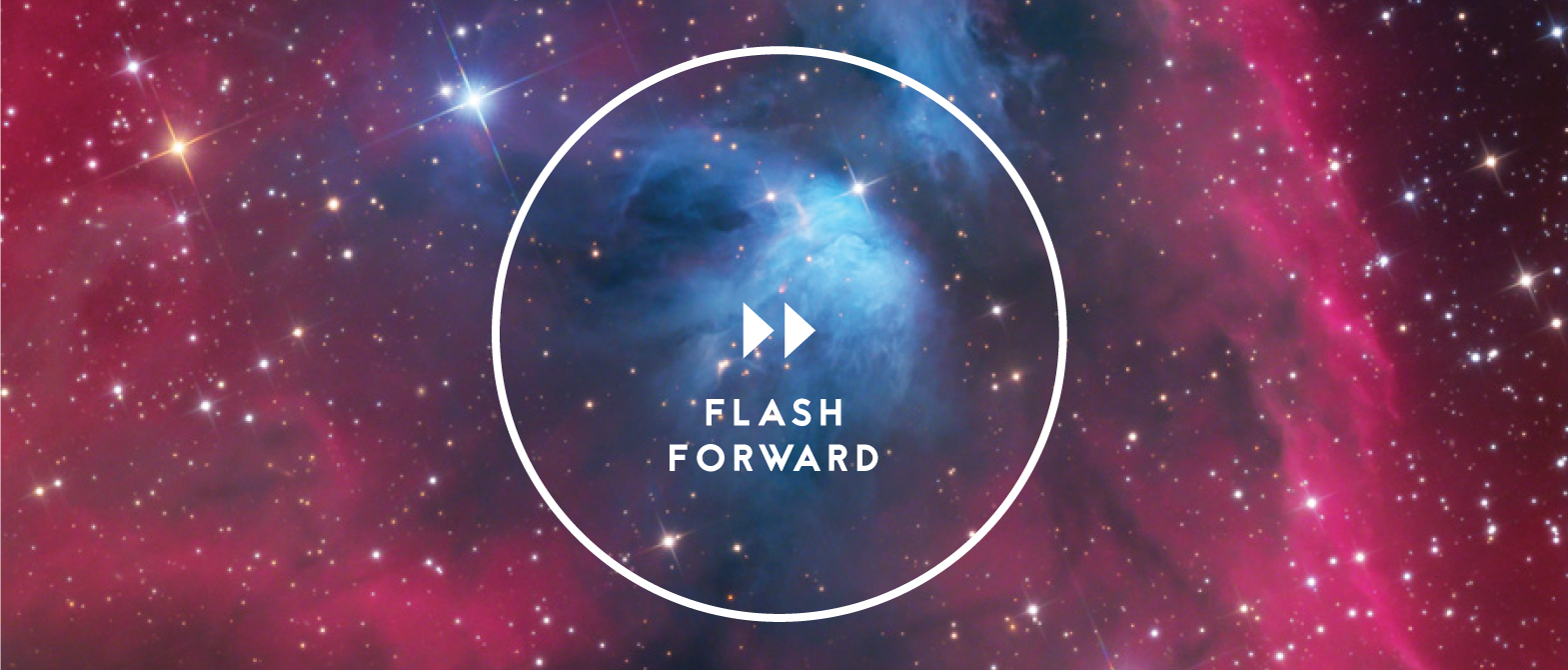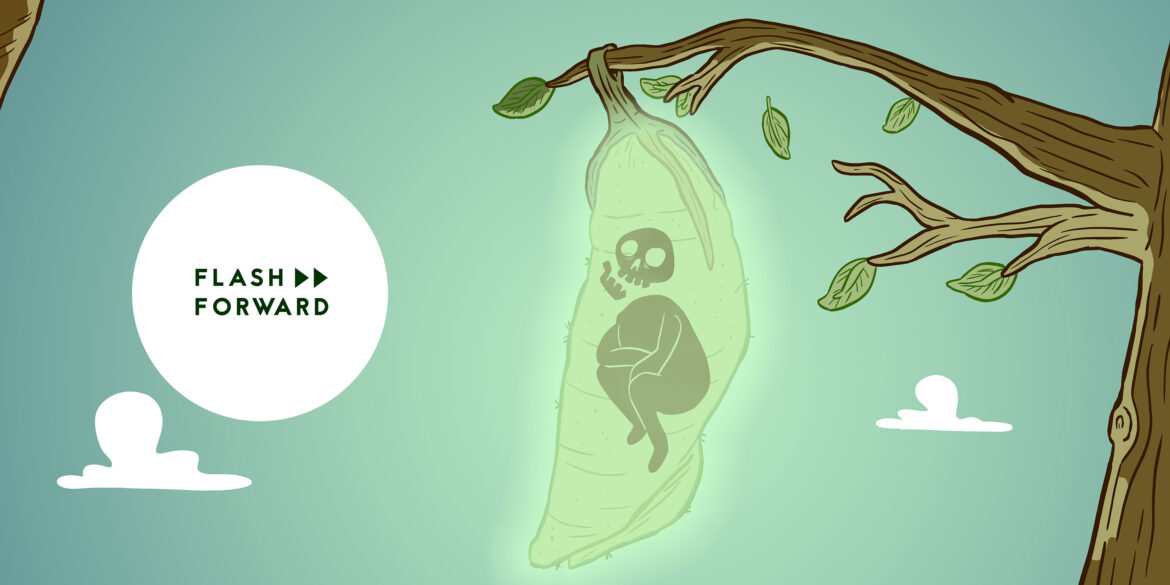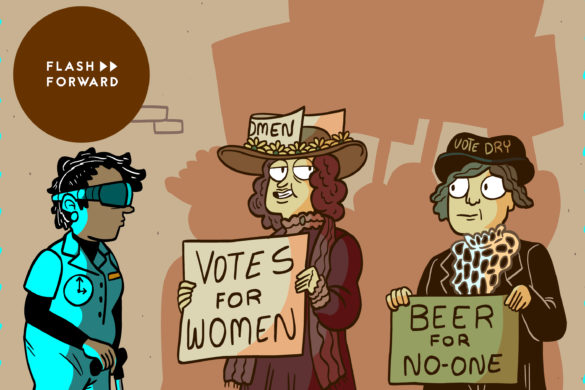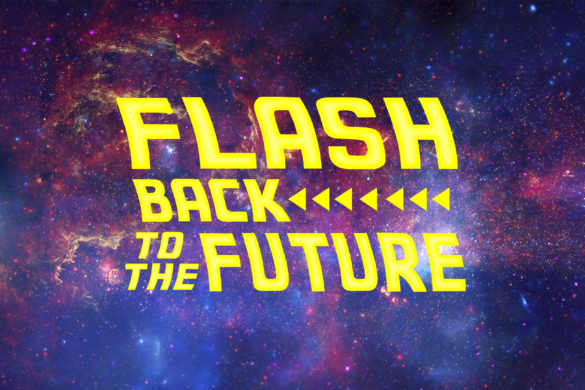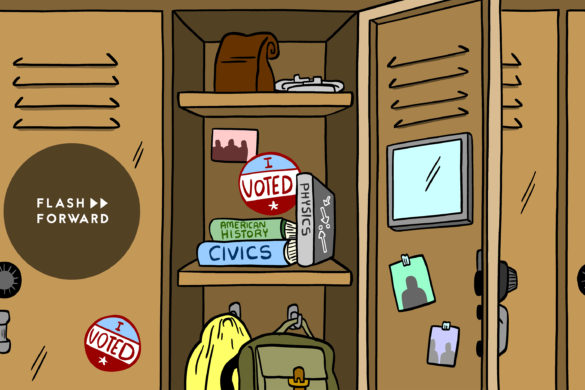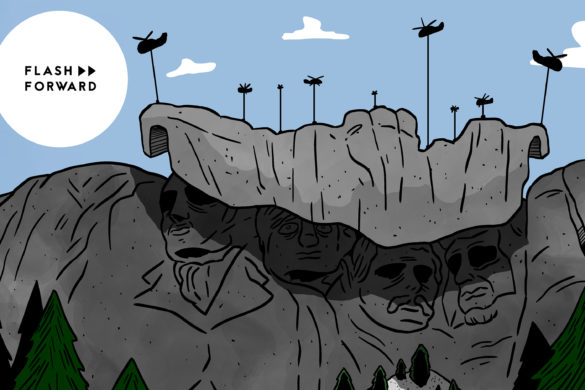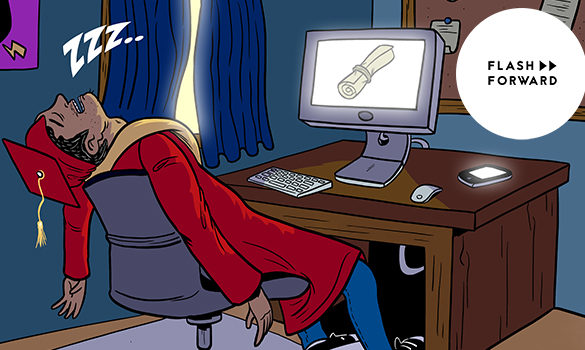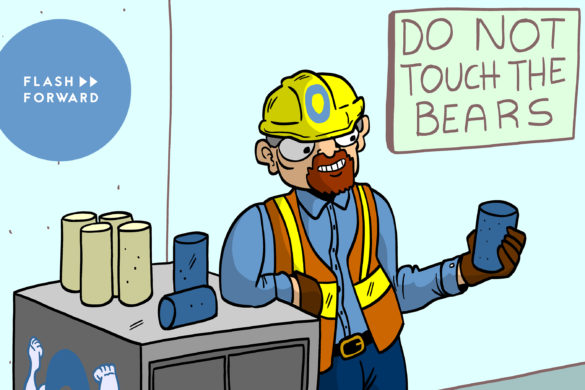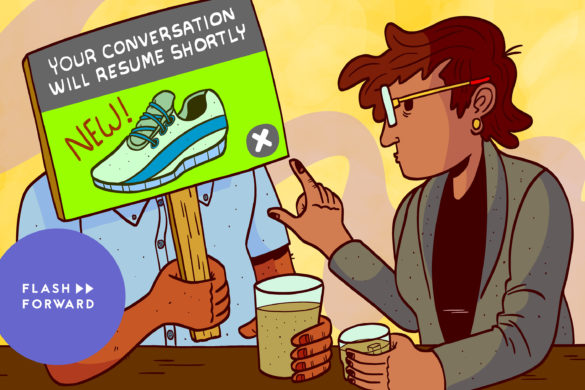Welcome to the end of Flash Forward. This is the very last episode of the show ever. And on it we tackle the big, BIG question: how do you change the world? How do you change yourself? How do you change tomorrow?
Guests:
- Dr. Jessica Ware — associate curator of invertebrates at the American Museum of Natural History
- Sabrina Imbler — journalist and author of How Far the Light Reaches: A Life in Ten Sea Creatures.
- Dean Spade — law professor at Seattle University School of Law and author of Mutual Aid: Building Solidarity During this Crisis (and the Next)
- Dr. Ruha Benjamin — professor of African American studies at Princeton University and author of Viral Justice: How We Grow the World We Want
- Liz Neeley — science communicator and founder of Liminal
Further Reading:
- How Does a Caterpillar Turn into a Butterfly?
- How Far the Light Reaches: A Life in Ten Sea Creatures
- Sonnet Against Entropy by John M. Ford
- My Metamorphosis
- The Mad Hatterpillar
- Mutual Aid: Building Solidarity During This Crisis (and the next)
- The ‘sheep’ that can photosynthesise
- Small but deadly: The chemical warfare of sea slugs
- Viral Justice: How We Grow the World We Want
- “The Hermit Crab” by Mary Oliver
- Meet The Magnificently Weird Mola Mola
- “That is solemn we have ended” by Emily Dickinson
Poem Credits:
Sonnet Against Entropy, by John M. Ford, published by Tor in 2011
“The Hermit Crab” by Mary Oliver. Read by the permission of The Charlotte Sheedy Literary Agency as agent for the author. Copyright © 1990, 2006, 2008, 2017 by Mary Oliver with permission of Bill Reichblum
That is solemn we have ended,— (87), by Emily Dickinson (public domain)
This episode of Flash Forward was written by me, Rose Eveleth, edited by Avery Trufelman, produced by Ozzy Llinas Goodman and sound designed by Ariana Martinez. Much of the music in this episode is by Ilan Blanck. The outro music is by Hussalonia. The episode art is by Mattie Lubchansky.
Special thanks to Kendra Snyder at the Museum of Natural History; Cass Adair, who read Sonnet Against Entropy by John M. Ford; Elena Rivera, who read The Hermit Crab by Mary Oliver; and to Siona Petrous, who read our Octavia Butler quote.
That’s all for Flash Forward, go forth and make better futures, okay?
FULL TRANSCRIPT BELOW
(Transcript by Emily White at The Wordary)
▹▹ ▹▹ ▹▹ ▹▹ ▹▹ ▹▹ ▹▹ ▹▹ ▹▹ ▹▹ ▹▹ ▹▹ ▹▹ ▹▹ ▹▹ ▹▹ ▹▹ ▹▹ ▹▹ ▹▹ ▹▹ ▹▹ ▹▹
FLASH FORWARD
S9E3 – “PUPATION”
ROSE EVELETH:
Flash Forward is, as you’ve heard me say approximately 180 times and counting, a show about the future. Sure, it’s about cool science, and tech, and research, and sometimes aliens. But fundamentally, it’s about the ways that tomorrow could be different from today. Since the beginning, this show has been a way for me to explore ideas of change. How do we change the world for the better? How do we become the people we want to be? How do we make the futures we want?
This is a literal question, one that has real, on-the-ground answers. But it can also be served, I think, by metaphors.
[soft electronic notes pules in the background]
At some point in the past, someone who lived where I now live in Berkeley planted a butterfly bush. I didn’t know that’s what it was, being a person who always thinks that I will learn about plants and then never does. I only figured it out when the butterflies started coming to it. Monarchs, specifically; those beautiful black and orange beacons of spring.
Actually, that’s a lie. I noticed the caterpillars first, eating the plant. And then I did a search to figure out if I should kill them, if they were some kind of terrible invasive species I’ve never heard of that I should eradicate immediately and with glee. They were not.
Have you ever tried to watch, in real time, a caterpillar turning into a butterfly? It happens in two parts, as you probably know. First, the caterpillar finds a spot on a leaf, a branch. Then, the soft, smooshy caterpillar spins a protective exoskeleton. The ones monarchs make are a beautiful leafy green with gold flecks. Other butterflies have even more striking shells. The Tithoria butterfly’s chrysalis looks like it belongs around the neck of some ostentatious, possibly inbred, royal princess — a pure, shiny gold, so reflective you can see yourself in it.
But the real magic is what happens inside this golden shell.
DR. JESSICA WARE:
There’s a complete rearrangement of their internal and external anatomy during the pupal stage.
ROSE:
This is Dr. Jessica Ware, an associate curator of invertebrates at the American Museum of Natural History. And a complete rearrangement of internal and external anatomy is no small feat. And for butterflies, to achieve this rearrangement, they must first turn into goo.
[music crescendos and fades away]
JESSICA:
Basically, the cells kind of spit out these caustic agents that basically dissolve, you know, completely, the larval mussels.
ROSE:
Not every single part of the caterpillar is melted — things like the little tiny antenna nubs that a caterpillar has will simply grow longer to become the long, butterfly antenna. And amidst the goo, there are clusters of cells called “imaginal discs,” which will go on to become the new parts of the butterfly. I love that bit of jargon: imaginal discs. The term comes from the same Latin root as the word “imagination” — the concept of being whatever you can picture yourself to be.
JESSICA:
So some parts of it, you imagine just being goo; you know, turning to goo. And other parts are kind of developed into something that will then become an adult.
ROSE:
And I asked Jessica, does this hurt? I mean it really sounds like it would hurt!
JESSICA:
Oh, that is a good question. So we don’t often talk about pain in insects, although some people feel very strongly that there’s evidence that some of the nerve signals that they’re experiencing might be related to pain. We don’t often like to think about pain in insects because we would rather be cavalier with their lives. Right? So that’s a very good question. I don’t know the answer, really. I imagine that complete dissolving of your internal musculature probably would… I imagine that, you know, might make you feel some kind of way.
[pulsing music returns]
ROSE:
Once the caterpillar is dissolved into goo, it then reforms itself into the next stage. Those imaginal discs each start to do their jobs, becoming wings, and legs, and eyes, and so on.
And when that process is done, the butterfly emerges from its protective case and flies away.
AI ROSE:
Mounting pressure for change usually succeeds in undoing a monolith so that fresh new ways can take over.
ROSE:
This part — the emerging — happens way faster than I realized. For weeks I tried to catch the act as it happened in my backyard, checking on my little melting and reforming caterpillars every couple of hours. But I kept missing it. One minute you’ve got a pretty little gem of a chrysalis, and the next it’s a paper-thin empty husk and your butterfly is off to see the world without you.
But I am nothing if not determined. So after failing several times to witness the butterfly emerging triumphantly from the chrysalis, I took matters into my own hands and brought a chrysalis inside — propping it up right next to my desk.
[music changes to slow, somber]
A few days later, I learned that there is something called a Tachinid fly that lays eggs on monarch caterpillars. Once the caterpillar is all nicely wrapped up in its cocoon, the maggots get to work, boring into the poor fleshy body, and eating it. Long story short, I didn’t get a butterfly. Instead, I got a maggot.
Maybe there’s a metaphor there, but we are going to skip it for now and go to the other metaphors that exist in the world of caterpillars and butterflies. And they’re almost always about upgrading. The caterpillar is always the stodgy, slow-moving thing confined to the ground. In some versions of the story, the cocoon represents crisis and depression, the whole “it’s always darkest before the dawn” thing. The butterfly is the dawn. The free, floaty, flying thing.
AI ROSE:
Many people genuinely care for the beauty and awe of this world and its beings.
ROSE:
I mean, everybody loves a butterfly. Well, everybody except Jessica.
[music fades away]
ROSE (on call):
Everyone loves a butterfly.
JESSICA:
Blegh. (laughs)
ROSE:
(laughs) Wait, say more about that.
JESSICA:
But I mean, butterflies are great. There’s a lot of them, but they’re like, you know, maybe we pay too much attention to beautiful things and we don’t pay enough attention to things that are less beautiful.
ROSE (mono):
I mean, have you looked at a caterpillar recently? Really looked?
JESSICA:
A lot of caterpillars are beautiful, I think.
ROSE:
For example- The Great Peacock moth caterpillar is dotted with incredible bright blue nodes, looking like a piece of sour candy. The Euclea Norba moth caterpillar has a series of translucent spikes that look like beautiful, deadly lace. And butterflies might be pretty, but so are a ton of other insects!
JESSICA:
Dragonflies are beautiful. But what about the lowly cockroach or the lowly earwig? You know, like there’s a lot of really cool insects out there, but they get no press, they get no greeting cards. You know, it’s all butterflies, butterflies, butterflies. So I’m a little jaded, maybe, because I feel for these other insects that have a really unique evolutionary history, but no one hears about it because all we’re doing is talking about butterflies.
ROSE:
Butterflies are not the only species of insect that does the whole pupation thing. In fact, by some estimates, around 60% of all animals do this thing that scientists call holometabolism. Ladybugs, beetles, bees, lacewings, flies, they all wrap themselves up and go through an incredible transformation. But we don’t celebrate those ones. We don’t put them on greeting cards or hairclips. Butterflies get all the attention.
JESSICA:
What I think is so remarkable to people is just the transformation from something that they would consider to be unattractive to something that is attractive. The idea that a small grub could become a giant beetle, that’s not really ratcheting it up in social status in terms of beauty, right?
ROSE:
But what if we set aside the beauty of the outcome, and just talk about the beauty of the transformation itself? The idea that you can close yourself up in a little protected shell, melt into goo, and then emerge as basically a completely different creature.
[soft aural music plays in background]
[dramatic reading by voice actor]
Sonnet Against Entropy
John M. Ford
The worm drives helically through the wood
And does not know the dust left in the bore
Once made the table integral and good;
And suddenly the crystal hits the floor.
Electrons find their paths in subtle ways,
A massless eddy in a trail of smoke;
The names of lovers, light of other days
Perhaps you will not miss them. That’s the joke.
The universe winds down. That’s how it’s made.
But memory is everything to lose;
Although some of the colors have to fade,
Do not believe you’ll get the chance to choose.
Regret, by definition, comes too late;
Say what you mean. Bear witness. Iterate.
SABRINA IMBLER:
I feel like the natural world, like, is where all of my realizations come from.
ROSE:
This is Sabrina Imbler, author of the book How Far the Light Reaches: A Life in Ten Sea Creatures.
[music fades away]
SABRINA:
I guess when I see a creature that is doing something weird that has, like, no human corollary, I guess that makes me kind of want to find it and try to seek it out in my own experience or in a way of seeing the world.
ROSE:
And maybe this is why I’m so interested in the metaphors that exist around change — like pupation. Because really, there is no real human equivalent. We are born roughly the same shape, and we simply grow larger. And older. But what can we learn from a creature that dissolves itself in order to move forward?
SABRINA:
I came across this really metal moth called the gumleaf skeletoniser, which is a moth in New Zealand.
ROSE:
Many caterpillars go through several molts before they hole up in their chrysalis — shedding their outer skin as they chomp on leaves and grow bigger. And when they shed a layer of skin, usually… they eat it.
SABRINA:
So that, like, predators won’t find it. It’s also extra nutrients.
ROSE:
But the gumleaf skeletoniser has put its own twist on this process.
SABRINA:
The gumleaf skeletoniser or caterpillar also does this, except it retains its old head and just puts it, like, atop its current head. And after its five or so molts, it just has this little tower of heads, like, on the top of its head.
ROSE:
Entomologist Gwen Pearson once called the gumleaf skeletoniser the “mad hatterpillar.” And for Sabrina, this offered a new kind of metaphor for change.
SABRINA:
How are the ways in which I’ve molted in my life and, like, what are the past selves that I want to cling to in the same way that this caterpillar retains all of its past selves? And I guess I was thinking about this a lot as someone who recently came to understand themselves as trans, but not in a very, like, linear way and not in a way that was, like, I’ve always known this since I was a child. And trying to make sense of various selves I’ve lived that, like, made sense in the moment but no longer makes sense to me.
ROSE:
A lot of trans folks I’ve talked to, actually, identify with the metaphor of metamorphosis.
DEAN SPADE:
You know, sometimes I’m drawn to the caterpillar-butterfly metaphor because I love that, like, yeah, they become nothing like themselves at all and then show up some other way.
ROSE:
That’s Dean Spade, a professor at Seattle University’s School of Law and the author of Mutual Aid: Building Solidarity During This Crisis (and the next).
DEAN:
I like the idea, the belief, that we can transform radically, like inside ourselves and that things we’re a part of can transform, and that that’s natural and normal.
[fluttering electronic notes play in background]
ROSE:
But the natural world is full of other metaphors too — ones that aren’t all about individual, personal growth. We can also look to nature for models of change that involve collaboration, or collective power.
DEAN:
I was thinking about… Just the other night at a bar, someone was telling me about these sea slugs that, when they consume other animals, take on those animals’ capacities.
ROSE:
Some of these sea slugs, for example, eat algae and actually extract the chloroplasts from that algae and use it to be able to photosynthesize themselves.
DEAN:
To me, that idea that I could, you know, collaborate with you or in a group and we could all get skilled up, and we could gain the best, most interesting skills that various people in the group have brought, or most interesting capacities.
[music transitions to sliding, trippy]
ROSE:
Other sea slugs that eat poisonous sponges, store that poison in their bodies to use as defense mechanisms. And this stacking of heads, this learning from our past selves and our current collaborators, that is how the big, metamorphic change happens. Together, in little units of exploration, and joining, and rejoining. That’s how we get to the transformation part.
DEAN:
We are each a very small part of something very big and, like, none of us can see our projects, like, succeed in fixing everything in this lifetime.
ROSE:
Big, but also brutal. These transitions, these changes — eating poison, turning to goo — they’re not the most pleasant, pain-free experiences. When you think about it, a pupation metaphor is pretty gnarly.
[music fades away]
RUHA BENJAMIN:
A major part of that process of, you know, the butterfly coming out is that squeeze. You know, that sense of pain and discomfort that comes with leaving that safe haven.
ROSE:
That’s Dr. Ruha Benjamin, author of Viral Justice: How We Grow the World We Want.
RUHA:
And so for me, it’s useful because I really want us to embrace the contractions or the pain, whatever – you know, whether it’s birth or the butterfly – rather than trying to skip over it. Like so many of the buzzwords, what sociologists call ‘happy talk’ when it comes to, you know, diversity, inclusion, equity, is trying to, like, somersault over the discomfort, and the pain, and the contractions. And so, I like that metaphor because if we pay attention to the different stages, there’s a lot… It’s not just a happy, you know, transformative process. There’s a lot of squeeze and discomfort that’s part of that metamorphosis.
[beach sounds play in background, ocean waves, birds]
ROSE:
For many, many creatures, periods of change are also periods of vulnerability. Take for example, hermit crabs, who live in their little homes until they outgrow them. When a hermit crab needs to find a new shell, needs to update its life and living conditions, it has to scurry about with its vulnerable backside hanging out until it fits into its new place. But these vulnerable moments of transition, they don’t always have to be solitary and scary. You don’t always have to go through them alone. Hermit crabs know this too. Scientists have documented situations in which hermit crabs will essentially line up in size order, so they can all trade with each other and shuffle into their new shells at once, minimizing the danger to everybody.
[beach sounds continue with fluttering notes]
[dramatic reading by voice actor]
The Hermit Crab
by Mary Oliver.
Once I looked inside
the darkness
of a shell folded like a pastry
and there was a fancy face—
or almost a face—
it turned away
and frisked up its brawny forearms
so quickly
against the light
and my looking in
I scarcely had time to see it,
gleaming
under the pure white roof
of old calcium
When I set it down, it hurried
along the tideline
of the sea,
which was slashing along as usual,
shouting and hissing
toward the future,
turning its back
with every tide on the past,
leaving the shore littered
every morning
with more ornaments of death—
what a pearly rubble
from which to choose a house
like a white flower—
and what a rebellion
to leap into it
and hold on,
connecting everything,
the past to the future—
which is of course the miracle—
which is the only argument there is
against the sea.
[music fades away]
All of these metaphors for change share some commonalities. They each tell stories of vulnerability. Of pain, tightness, discomfort as you have to change yourself and your world. The willingness to suffer a little, to be uncomfortable, as you try to try and push yourself into a new form, a new environment, a new place.
SABRINA:
I guess I feel like I just emerged from like a period of goo-dom; and like, of course I’ll go back to being goo at some point.
ROSE:
Sabrina Imbler again.
SABRINA:
Nothing is fixed and everything can change.
ROSE:
And this is the question that I always return to, the one that I have struggled with for a long time. It’s about goo. Must we fully dissolve ourselves and our world in order to get to the futures we want? In other words, do we have to burn it all down, destroy it all, and rebuild from that melted space?
DEAN:
I do appreciate the sentiment of burn it down. I think it’s actually really essential in a society in which we’re encouraged to be demobilized and passive.
ROSE:
Law professor Dean Spade again.
DEAN:
And so, it is meaningful for people to be like “burn it down.” Like, I think that’s an important intervention, even though it’s not like something any one of us, or any group we’re in, can do. I mean, that’s not how change happens. It happens, like, in really complex multiple levels with lots and lots of autonomous groups and people trying different things everywhere, and trying to get inspired by each other, and sharing ideas, and influencing each other, and debating. It’s just really complex and also a great deal that is unknown.
ROSE:
Over the years, we have talked a lot on this show about the pitfalls of personal responsibility. How you, alone, are not going to end climate change by recycling, no matter what the fossil fuel corporations tell you.
LIZ NEELEY:
“Oh, you just need to, like, ‘individual responsibility’ your way out of the climate crisis. We can’t.
ROSE:
That’s Liz Neeley, our science communicator.
LIZ:
And I think this goes to the problem with hopewashing, too. We have to think about this from a systemic point of view and take collective action. And so, that’s where I go, is back to the idea of hope as a discipline and hope as a social practice. It’s not in my own feelings, it’s how I am in relation to other people in the world around me.
ROSE:
And yes, you’ve guessed it, there is another really good animal metaphor for this, too.
LIZ:
There is a giant ocean sunfish called the mola mola.
[busy electronic music scatters in the background]
ROSE:
The mola mola is, actually, my favorite fish. I have a tattoo of one.
LIZ:
And by the time they’re adults, they can be massive, like 3,000, 4,000 pounds. Like, that’s essentially the size of my car. I drive a Prius.
ROSE:
They look like if a giant fish had been bitten in half by a shark, and that bite healed up but the fish’s face was still caught in the expression it made when the bite happened, like, “Can you believe what’s happening to me?!”
LIZ:
But they start life as tiny, tiny larvae. Right? They are, like, three millimeters long.
ROSE:
That’s about half the length of a grain of rice. Over the course of their lives, a mola mola increases its body mass 60 million times. And it’s not just that they get bigger. Humans get bigger too. When you live in water, the difference between being a fraction of a grain of rice and 1,000 kilograms, is fundamental!
LIZ:
The world is so different. Even, like, how much effort it takes to move through water, which at that size, like, it’s heavy, it’s thick, it’s gloppy. You’re kind of swimming through syrup.
[music fades away]
ROSE:
So that giant, car-sized fish is swimming through the ocean with some inkling of what it was like to be tiny, vulnerable, swimming against muck. This absolute behemoth has known what it was like to be so small and so helpless.
RUHA:
The dichotomy between big and small, between macro and micro, is a false one.
ROSE:
Once again, Dr. Ruha Benjamin.
RUHA:
We can see the interconnectedness, how something that seems small can build, and accumulate, and change things over time. And so, it’s a way of looking at the things around us and perceiving and respecting what we do on the small scale. That, I think, is essentially a love letter to people who are doing things that may not get a lot of attention, that may not get the headlines or, you know, the, the, the hashtags, but that are really vital for any long-term movement or process of world building.
[pulsing electronic notes begin]
AI ROSE:
When you model the kind of change you want to see spread, you spark virtuous ripples.
ROSE:
There is an Octavia Butler quote I return to over and over again. She said:
[read by voice actor] There’s no single answer that will solve all our future problems. There’s no magic bullet. Instead, there are thousands of answers — at least. You can be one of them if you choose to be.
We all are going to have to go through our own individual pupations to get to the world we want. But we’ll also need to remember how we were before, and imagine how we might yet change. We all have things to unlearn, re-learn, learn for the first time. We are all going to have to become uncomfortable in order to get to the future that can nurture and sustain us all equitably. You don’t need to have hope to do that, but it can help. And if you do have hope, it doesn’t need to be for some idealized future version of you, alone, being a beautiful butterfly. It can be about how you fit into the great, strange, changing world that is morphing and pupating in a thousand different ways all around you all the time.
[music continues to pulse thoughtfully]
And now, dear listeners, after almost eight years, and 182 episodes, I’m off to rearrange my own imaginal discs. And I want to leave you with one last poem.
That is solemn we have ended
by Emily Dickinson
That is solemn we have ended, —Be it but a play,Or a glee among the garrets,Or a holiday,Or a leaving home; or later,Parting with a worldWe have understood, for betterStill it be unfurled.
[music hovers for contemplation, then switches to Flash Forward closing music begins – a snapping, synthy piece]
This very final, last-ever episode of Flash Forward was written by me, Rose Eveleth; edited by Avery Trufelman; produced by Ozzy Llinas Goodman, and sound designed by Ariana Martinez.
Special thanks to Kendra Snyder at the Museum of Natural History; to Cass Adair, who read “Sonnet Against Entropy” by John M. Ford; to Elena Rivera, who read “The Hermit Crab” by Mary Oliver; and to Siona Petrous, who read our Octavia Butler quote. Obviously thanks to all the poets who allowed us to use their work in this series.
You can find a full script of this episode, as always, on FlashForwardPod.com. The episode art is, as always, by Mattie Lubchansky. And the outro music you’re hearing is, as always, by Hussalonia.
This is the LAST episode in our show’s finale. That’s it. It’s over! Can you believe it? Did I tear up when reading that Emily Dickinson poem? Yes, yes I did.
If you enjoyed Flash Forward, and want to support my future work on books, other shows, art projects, whatever else that I get up to in the future, you can do that by joining my membership program. It’s called the Time Travelers Club and if you go to FFWDPresents.com you can find out more about that. And if you are listening to this, the credits of this final episode, you are one of my favorite people and so you get a special discount code for that membership program. Use the code GOO, at checkout for 30% off your first year of Time Traveler Membership, FFWDPresents.com. There’s also going to be a link in the show notes.
That’s all for Flash Forward. Go forth and make better futures, okay?
[music continues to play until conclusion, fades away]
